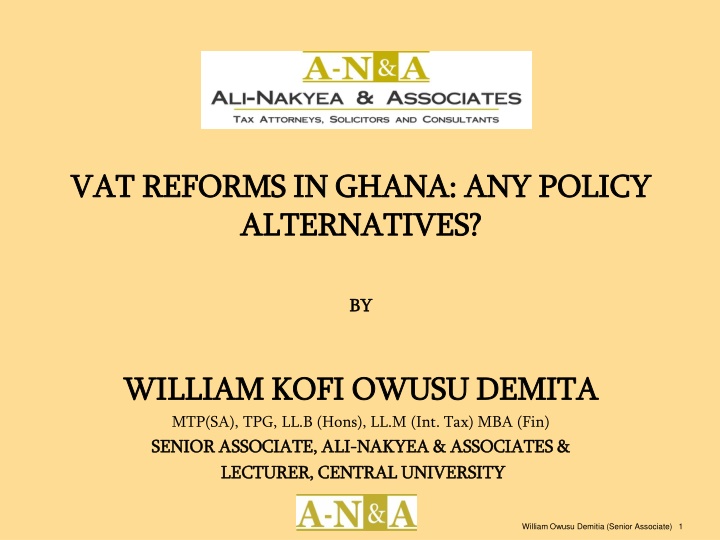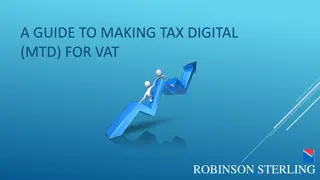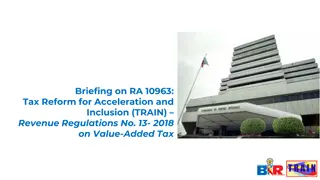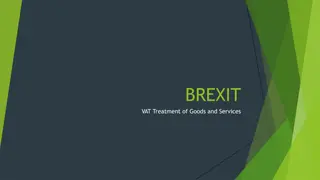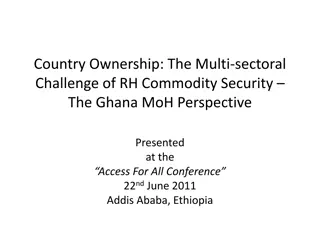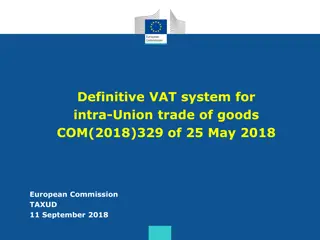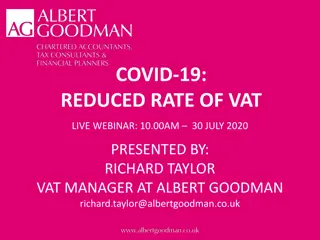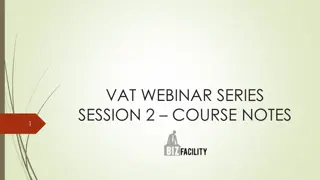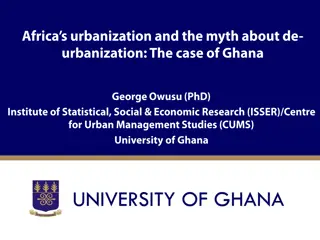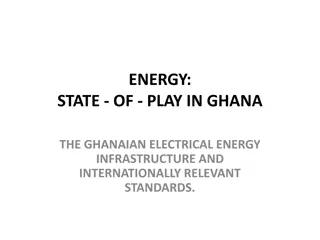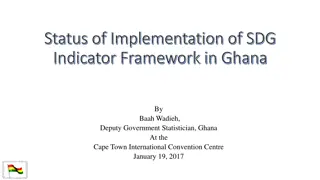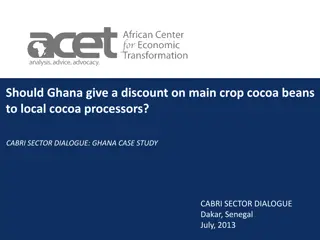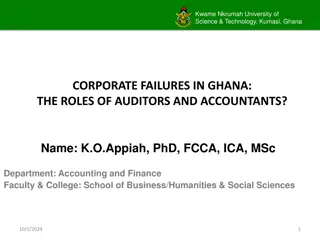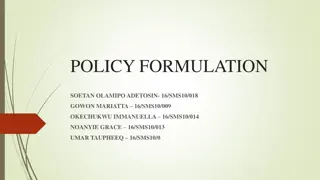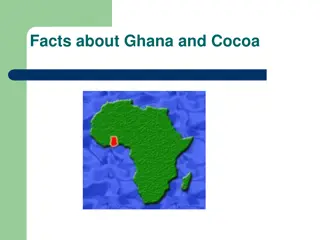VAT Reforms in Ghana: Policy Alternatives by William Kofi Owusu Demita
VAT Reforms and policy alternatives in Ghana discussed by William Kofi Owusu Demita, a Senior Associate at Ali-Nakyea & Associates. The history of VAT in Ghana, its implementation, and comparisons with sales tax are explored in the context of global VAT trends.
Download Presentation

Please find below an Image/Link to download the presentation.
The content on the website is provided AS IS for your information and personal use only. It may not be sold, licensed, or shared on other websites without obtaining consent from the author.If you encounter any issues during the download, it is possible that the publisher has removed the file from their server.
You are allowed to download the files provided on this website for personal or commercial use, subject to the condition that they are used lawfully. All files are the property of their respective owners.
The content on the website is provided AS IS for your information and personal use only. It may not be sold, licensed, or shared on other websites without obtaining consent from the author.
E N D
Presentation Transcript
ALI-NAKYEA & ASSOCIATES VAT REFORMS IN GHANA: ANY POLICY VAT REFORMS IN GHANA: ANY POLICY ALTERNATIVES? ALTERNATIVES? BY BY WILLIAM KOFI OWUSU DEMITA WILLIAM KOFI OWUSU DEMITA MTP(SA), TPG, LL.B (Hons), LL.M (Int. Tax) MBA (Fin) SENIOR ASSOCIATE, ALI SENIOR ASSOCIATE, ALI- -NAKYEA & ASSOCIATES & NAKYEA & ASSOCIATES & LECTURER, CENTRAL UNIVERSITY LECTURER, CENTRAL UNIVERSITY William Owusu Demitia (Senior Associate) 1
Introduction France is often credited as the first country to introduce VAT on an extensive scale in 1954. Since then, there has been a meteoric rise in the introduction of VAT in many developed and in developing countries across the world. Developing countries embraced consumption-based taxes such as VAT due to the existence of a large informal sector within these economies. William Owusu Demitia (Senior Associate) 2
Introduction Value Added Tax (VAT) is an indirect tax in the sense that it is a tax which is not directly levied on income. It is imposed on production and consumption. Other similar indirect taxes are the Goods and Services Tax (GST) and the Sales Tax. expenditure through William Owusu Demitia (Senior Associate) 3
Introduction The Organisation of Economic Cooperation and Development (OECD) in the 2015 International VAT/GST Guidelines seems to suggest that VAT and GST are the same in the preface of the guidelines. Sales Tax on the other hand is different from VAT/GST. Sales Tax, unlike VAT is imposed on the gross price of goods at the retail or sale point. William Owusu Demitia (Senior Associate) 4
Introduction not taxes The deductions exclusively and necessarily in the conduct of its business. Sales tax has been found to be one of the least harmful to growth albeit regressive. The current VFRS resembles a sales tax, however unlike a sales tax the VFRS applies to wholesalers and retailers likelihood of an extreme cascading effect. retailer is for allowed any kind wholly, of incurred which has the William Owusu Demitia (Senior Associate) 5
History of VAT in Ghana The Value Added Tax Act of 1994 (Act 486) introduced VAT in Ghana to replace the existing Sales Tax. However, the Act was never implemented due to the strong opposition it received from inception as a bill through to the time it was passed. VAT was successfully implemented under the Value Added Tax Act, 1998 (Act 546). William Owusu Demitia (Senior Associate) 6
History of VAT in Ghana Act 546 adopted the invoice-credit method which permitted deductions of input tax on purchases made by businesses. (section 24 of Act 546). Act 734 introduced the Flat Rate VAT Scheme in 2007 (24thMay, 2007). The Flat Rate Scheme was applicable to persons whose turnover for a twelve month period ranged from GHS90,000 GHS10,000 to William Owusu Demitia (Senior Associate) 7
Application of Flat Rate VAT Scheme under Act 734 For the avoidance of doubt Act 734, as amended, stated in section 2 as follows: (2) Unless otherwise Commissioner-General in writing, a taxable person who is a retailer of goods shall account for the Value Added Tax payable under this section at a flat rate of 3% calculated on the value of the taxable supply . Section 1 of Act 734 also provided that (6a) A taxable person to whom subsection (2) of section 3 applies does not qualify for input tax deduction or tax credit . directed by the William Owusu Demitia (Senior Associate) 8
History of VAT in Ghana Retailers under the Flat Rate VAT Scheme, they were not allowed input tax deductions (section 24(6A) of Act 546). When the Value Added Tax, 2013 (Act 870) was passed into law, there was no provision in the Act for flat rate scheme. The justification provided for the removal of the flat rate scheme from Act 870 was that the flat rate scheme created distortions in the administration of the tax. William Owusu Demitia (Senior Associate) 9
Application of Flat Rate VAT Scheme under Act 948 Section 1 of Act 948 provides in section 1(a) as follows: (2) A taxable person who is a retailer or wholesaler of goods shall account for the Value Added Tax payable under this section at a flat rate of three percent calculated on the value of the taxable supply . Section 1(b) also provides that (3) Subsection (2) does not apply to the supply of goods specified under section 27. William Owusu Demitia (Senior Associate) 10
Application of Flat Rate VAT Scheme under Act 948 Section 27 of Act 870 deals with supply of and form of power, heat, refrigeration or ventilation. Section 2(b) of Act 948 also provides that (7A) A taxable person to whom subsection (2) of section 3 applies does not qualify for input tax deduction in respect of a supply of goods . William Owusu Demitia (Senior Associate) 11
CONTROVERSIES With the passage of the law introducing VAT flat rate, the Ghana Revenue Authority published a Practice Note on its application. With regards to the scope of the flat rate, the practice note states that; The VFRS is restricted (including importers) and retailers of taxable goods and does not cover manufacturers, service providers, etc. as provided for by section 3(2) of VAT Act 870 as amended by VAT (amendment) Act, 2017 (Act 948) to wholesalers William Owusu Demitia (Senior Associate) 12
CONTROVERSIES The inclusion of importers in the scope of the VAT flat rate is a misrepresentation of the law. Section 3(2) of Act 870 as amended by Act 948 provides as follows: A taxable person who is a retailer or wholesaler of goods shall account for the Value Added Tax section at a flat rate of three percent calculated on the value of the taxable supply. payable under this William Owusu Demitia (Senior Associate) 13
CONTROVERSIES Migrated Taxpayers having outstanding VAT credit balances with General which are as a result of input taxes on unsold stocks of goods, are to recover such credits as part of their cost build up to the selling prices of the unsold stocks of goods. (GRA Notice in B&FT, Wednesday, July 5, 2017 page 20). The above view published in the B&FT is stated in the Practice Note on VAT Flat Rate. the Commissioner- William Owusu Demitia (Senior Associate) 14
CONTROVERSIES Note should be taken that under article 107(b) of the 1992 Constitution, laws cannot be passed with retrospective effect. This is as below: 107(b). Retroactive legislation Parliament shall have no power to pass any law which operates retroactively limitations on, or to personal rights and liberties of any person or to impose a burden, obligation or liability on any person except in the case of a law enacted under articles 178 to 182 of this Constitution. to impose affect any the adversely William Owusu Demitia (Senior Associate) 15
CONTROVERSIES What then happens to the right to input tax deductibility accumulated and deductible under section 48 of Act 870? Having regard to the fact that a wholesaler or retailer of goods applying the VAT flat rate does not qualify to deduct input tax, the question on the minds of businesses will be the fate of accrued tax credits arising from excess deductible input in the previous tax regime. William Owusu Demitia (Senior Associate) 16
CONTROVERSIES Unfortunately, no transitional provisions have been made to determine how tax credits from the standard VAT regime should be treated. Ideally, the right to carry forward tax credits having been accrued must be allowed to be carried forward (section 50(13) of Act 870). Any attempt to deny businesses the right to carry forward their tax credit from the previous VAT regime and setting it off against their outputs under the VFRS will be a retrospective application of the amendment to affect accrued rights which would be unconstitutional under Article 107(b) of the 1992 Constitution. William Owusu Demitia (Senior Associate) 17
CONTROVERSIES Contrary to the opinion that the introduction of the 3% flat rate will lead to a reduction in prices, the VFRS would lead to cascading taxes and an increase in the tax burden on consumers through an increase in the price of commodities. The cascading effect of a tax occurs in a tax system in which a rate of tax is applied at every stage in the supply deduction for the taxes incurred at earlier stages. chain, without any William Owusu Demitia (Senior Associate) 18
CONTROVERSIES Therefore in the case of the VFRS, the cascading effect is the imposition of 3% on goods repeatedly through the supply chain, thus 3% on another 3%. The result is that the effective tax rate at the end of the supply chain is more than the initial tax rate imposed or the cascade tax. To put it simply, cascading tax is the act of imposing a tax on another tax. William Owusu Demitia (Senior Associate) 19
CONTROVERSIES The idea or opinion that the flat rate will lead to a reduction in prices proceeds on the premise that there is a total eradication of the 17.5% VAT/NHIL and therefore only the 3% VAT/NHIL is imposed on the cost of the product. This opinion fails to VAT/NHIL is 17.5% and the 3% Flat Rate will be computed on cost of the product which includes the import VAT/NHIL of 17.5%. consider that import William Owusu Demitia (Senior Associate) 20
CONTROVERSIES Practice Note of GRA Description (a) Cost price of item (b) Input Tax (17.5%*100) (c)Value Added (10% *117.50) (i.e. margin and other overheads) (d) Taxable Value (a+b+c) (e) Output tax @ 3% Flat Rate GHS 100 17.50 11.75 129.25 3.88 (f) VAT/NHIL payable (i.e. 3% Flat Rate) 3.88 (g) Cost to Consumer (tax inclusive) (d+f) 133.13 William Owusu Demitia (Senior Associate) 21
POLICY ALTERNATIVES The rationale behind the VFRS as stated by government is to make VAT simple to calculate and easy to understand; minimize the incentive of cheating; and to minimize the incidence of VAT avoidance. The Standard VAT rate applied to businesses with taxable supplies 200,000.00 at the end of any period of twelve or less months (Section 6 of Act 870). exceeding GHS William Owusu Demitia (Senior Associate) 22
POLICY ALTERNATIVES Practically, for businesses within this threshold, calculation of the VAT input and output was not a challenge unlike small retail businesses who do not have adequate records for that kind of calculation. From a policy perspective, VFRS should have been applicable to small retail businesses whose taxable supplies GHS200,000 threshold. This policy choice would have reduced the incidence of tax cascading associated with the current VFRS scheme are below the William Owusu Demitia (Senior Associate) 23
POLICY ALTERNATIVES Under the provisions of the Income Tax Act, 2015 (Act 896) there is an attempt to address the problems associated with the poor record keeping nature of small businesses through the vehicle of modified taxation. (Second Schedule of Act 896). William Owusu Demitia (Senior Associate) 24
POLICY ALTERNATIVES The modified taxation involves the imposition of a presumptive tax of 3% on resident individuals whose chargeable income consists exclusively of income from whose annual turnover GHS20,000 to GHS 200,000.00. Implementation of the presumptive tax by the GRA should cater for small businesses who are not required to register for VAT due to the threshold requirement and who find it difficult to calculate their input and output due to the absence of proper records. business and ranges from William Owusu Demitia (Senior Associate) 25
POLICY ALTERNATIVES Presumptive taxation is equally capable of minimizing the incidence of VAT avoidance which is especially prevalent among small retail businesses. William Owusu Demitia (Senior Associate) 26
Conclusion While the VFRS may have its advantages of generally being simpler perhaps increasing government, its impact on businesses, the consumer and the economy far outweighs its intended benefits. The cascading effect of the tax would lead to an increase in cost for businesses down the value chain which would consequently lead to an increase in the cost of commodities for the consumer. to revenue calculate and the tax for William Owusu Demitia (Senior Associate) 27
Conclusion The implementation of VFRS in its current form reaffirms the belief that the country lacks a coherent and comprehensive tax policy design. Going forward, an effective implementation of presumptive taxation under the Income Tax Act, 2015 (Act 896) would be able to meet the goals which government seeks to impose a VAT flat rate with a more favourable effect. William Owusu Demitia (Senior Associate) 28
END OF PRESENTATION THANK YOU Questions, Comments, Contributions William Owusu Demitia (Senior Associate) 29
